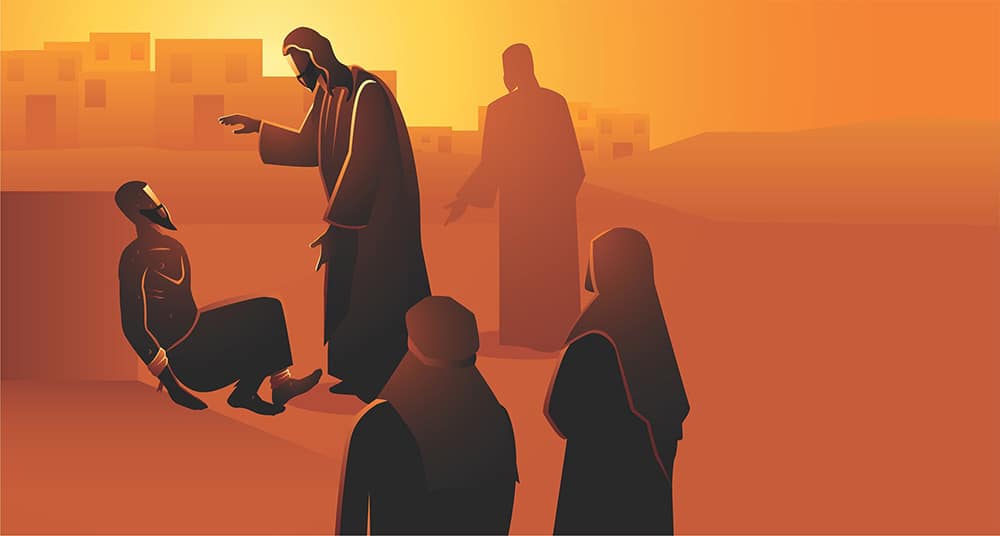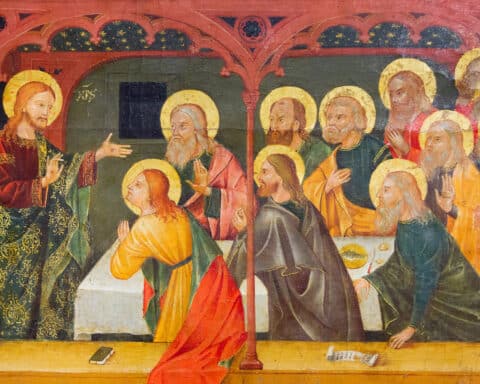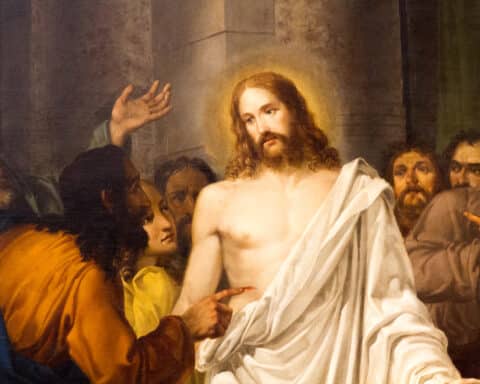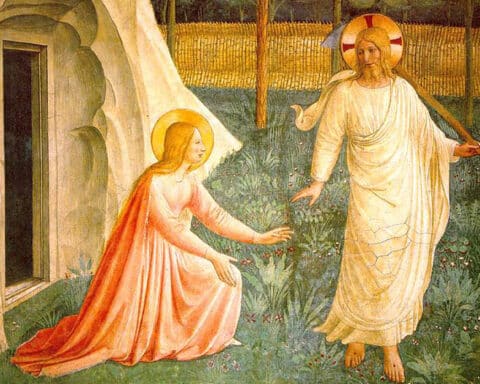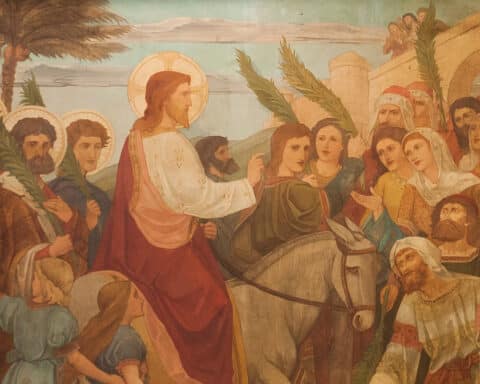This is the fifth in a 12-part series of In Focuses dedicated to exploring some central themes and texts in the Gospel of Matthew.
We profess belief in “one, holy, catholic and apostolic Church.” There is much to undermine that claim. The second of these four marks of the Church — “holy” — comes in for particular scorn in classes where I teach the creed. The events of recent decades alone lead us to wonder how the Church can identify itself as “holy.” A look further back into history only intensifies the question. So as to put the question in sharpest relief, the great theologian Hans Urs von Balthasar published a study on the sinfulness of the Church, entitled “Casta Meretrix.” Written in 1961 on the eve of the Second Vatican Council, the work recites a long litany of failure. There can be no papering over such things, and the Church is, on one hand, rightly indicted by all that the word meretrix (“prostitute”) implies. Even so — and Balthasar’s aim was not to tear down but to build up — the Church is always and everywhere casta (“chaste”). There is in her an ineliminable holiness. Were the Church just another human organization, just something of our own making, this would not be true in the least. But as St. Paul would have us understand, the Church is the Body of Christ (cf. 1 Cor 12:27). We are, Jesus teaches, branches of which he is the vine (cf. Jn 15:5). The Church is what it is in virtue of Jesus. As he is holy, so too is and will his body be. We can wound that body — we do so always — but as seen already in the Passion, death has no lasting sting. Despite what we do, the Church is and will be holy.
| 5 QUESTIONS TO CONSIDER |
|---|
|
While not in reference to these marks of the Church, the union of Jesus and his followers emerges as a central theme in the Gospel of Matthew. In one respect, the whole of the first Gospel is simply an exhortation and a guide to the imitation of Christ — “It is enough for the disciple that he become like his teacher, for the slave that he become like his master” (Mt 10:25). What Jesus says and does, his disciples are likewise to say and do.
Sending out the disciples
The structure of the Gospel makes this apparent. In the Sermon on the Mount (Mt 5-7), we are presented with Jesus’ teaching, and in Matthew 8-9, we are presented with his miracles. In chapter 10, Jesus sends his disciples to teach and to do likewise: “As you go, make this proclamation: ‘The kingdom of heaven is at hand.’ Cure the sick, raise the dead, cleanse lepers, drive out demons” (Mt 10:7-8). Indeed, this theme of imitation runs throughout the Gospel. In their “International Critical Commentary” on Matthew, W. D. Davies and D. C. Allison observe: “The disciples, like Jesus, go only to the lost sheep of the house of Israel (10.5; 15.24). They preach the same message Jesus preached (10.7; cf. 4.17). They heal the sick, raise the dead, cleanse lepers, and cast out demons (10.8) — all of which Jesus did (8.2-4, 14-17, 28-34; 9.18-26). They wander from town to town, just like Jesus (10.11; cf. 4.23-5); and, like their master, they stay in the homes of others (10.11; cf. 8-14-16; 9.10?). The apostles also suffer like Jesus. They flee …, are delivered up before councils, are flogged, and are dragged before governors (10.17-19; cf. 26.57-27.31). They in addition are betrayed by those closest to them, which recalls the betrayal of Jesus by one of the Twelve (10.21; cf. 26.47-56).”
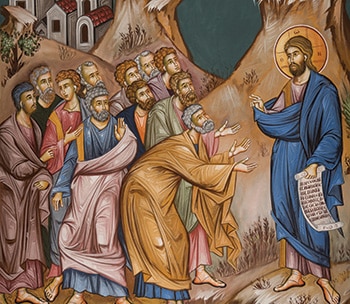
This correspondence amounts to more than mimicry. It is more than “imitation” in the weak sense we normally use the word (ie. imitation vanilla is not vanilla.) When the disciples act, they are an extension of the very mission and authority of Jesus. In the first chapter of Genesis, the first couple is the “image” and “likeness” of God in that they carry forward, at God’s command, the creative work which he has begun. So also here, Jesus makes disciples in his “image” and “likeness” whose own work is not an ape of their master’s work but a carrying forward of it. Thinking again with St. Paul, we can say that the disciples are Jesus’ body. By his authority they are able to announce that “The kingdom of heaven is at hand” and to enact that reality among their hearers.
What, though, is the substance of this task? What does it mean to announce the kingdom of heaven and to enact that reality? Here a closer look at Jesus’ miracles (Mt 8-9) is in order. In the Sermon on the Mount, Jesus teaches what life in the kingdom of heaven is like. The gratuity with which God loves us is to be the mark of our own existence. God “makes his sun rise on the bad and the good, and causes rain to fall on the just and the unjust,” so we must “love [our] enemies, and pray for those who persecute [us]” (Mt 5:45, 44). The whole of this teaching is exemplified in Jesus’ own life. He himself not only announces but makes present the reality of the kingdom.
Jesus’ miracles display this gratuitous love very poignantly. Speaking of his own ministry, Jesus says that he “was sent only to the lost sheep of the house of Israel” (Mt 15:24), and at first, he directs his disciples to do the same (cf. Mt 10:6). Even so, he does not restrict the blessing of the kingdom. A striking feature of the miracles in Matthew 8-9 is that they attend to the marginalized both within Israel as well as without. Jesus’ second healing in Matthew 8 — the healing of the Roman centurion’s servant — exemplifies this preference. So, too, do the centurion’s words in exemplify an ideal posture before Jesus: “Lord, I am not worthy to have you enter under my roof; only say the word and my servant will be healed” (Mt 8:8). The same gratuity characterizes the other miracles as well. He attends to the sick, the blind, the mute, the paralyzed, the possessed and even the dead.
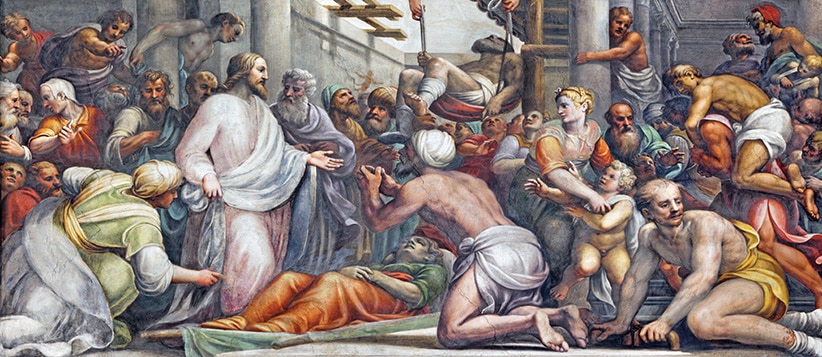
Fulfilling the Scriptures
The nearness of these miracles to the Sermon on the Mount shows that Jesus’ words were understood not simply as a new teaching but the inbreaking of a new reality. In the person of Jesus, God’s power was known to be present in Israel in an astonishing way, and that power was directed to all. “When Jesus came down from the mountain” (Mt 8:1), he was immediately approached by a leper who asked to be healed. This man knows plainly that Jesus is capable of healing him; the question is only whether Jesus wills to do so: “Lord, if you wish, you can make me clean” (Mt 8:2). In his reply — “I will do it. Be made clean” (Mt 8:3) — Jesus confirms his authority. The announcement of God’s gratuitous love is made manifest and concretized is all that does for those who suffer.
Matthew is keen to show, however, that these actions are not ends in themselves. It is true that Jesus “went around all of Galilee … curing every disease and illness among the people” (Mt 4:23), but these miracles are not the real substance and goal of Jesus’ mission. After his cure of the leper, the centurion’s servant, Peter’s mother-in-law and others, Matthew notes that all this had taken place “to fulfill what had been said by Isaiah the prophet: ‘He took away our infirmities and bore our diseases'” (Mt 8:17; cf. Is 53:4). The miracles of Jesus take place in fulfillment of the Scriptures. He is the servant of whom God spoke through Isaiah. His miracles attest, therefore, not only to God’s power in the present (of Jesus’ day) but across the span of Israel’s past. In Jesus Matthew asks us to see the outworking of all that God intends for Israel.
This is especially apparent a few chapters on when John the Baptist, reaches out to Jesus from his captivity: “When John heard in prison of the works of the Messiah, he sent his disciples to him with this question, ‘Are you the one who is to come, or should we look for another?’ Jesus said to them in reply, ‘Go and tell John what you hear and see: the blind regain their sight, the lame walk, lepers are cleansed, the deaf hear, the dead are raised, and the poor have the good news proclaimed to them” (Mt 11:2-5). Jesus’ reply pieces together various portions from the Book of Isaiah (cf. Is 26:19; 29:18-19; 35:5-6; 61:1). What the prophet announced concerning the restoration of Israel now takes place through the person of Jesus. The gratuitous love announced by Jesus shows itself, therefore, not as an isolated blessing of God but the very substance of what God has intended from the first. It is the realization of the hope of Israel.

Revelation of inner healing
Again, however, the miracles themselves are not the substance and end of Jesus’s ministry. In the words of Jesus just cited, we see something of a progression. Healing culminates in “the good news proclaimed” to “the poor.” The miracles are the announcement and proof of the more radical healing Jesus brings. At the beginning of the ninth chapter, a paralytic man is brought to Jesus. Rather than say “Be healed!” Jesus first says to him “Courage, child, your sins are forgiven” (Mt 9:2). This evokes the ire of the scribes, who say to themselves “This man is blaspheming” (Mt 9:3). Jesus begins his reply to the scribes with a rhetorical question: “Which is easier, to say, ‘Your sins are forgiven,’ or to say, ‘Rise and walk?'” (Mt 9:5). In truth, the first is harder, for it is God’s prerogative to forgive sin. Then, again, since the announcement of forgiveness is not accompanied by any outward sign, it is all the easier to say. Whether such words have any effect is hidden from view; one could easily say them falsely, and this is what the scribes accuse Jesus of. So as to show that he works with authority — that his words of forgiveness are not without effect — Jesus brings about that which is visible: “‘But that you may know that the Son of Man has authority on earth to forgive sins’ — he then said to the paralytic, ‘Rise, pick up your stretcher, and go home.’ He rose and went home. When the crowds saw this they were struck with awe and glorified God who had given such authority to human beings” (Mt 9:6-8). The outward sign — the healing of the paralytic — is itself the sign of a more important reality. “The good news” proclaimed to “the poor” is the forgiveness of sins. The gratuitous love of God culminates not in the healing of the flesh but in the forgiveness of sin and so the restoration of the whole person.
The call of Matthew follows this healing and makes this priority of the soul clear: “While he was at table in [Matthew’s] house, many tax collectors and sinners came and sat with Jesus and his disciples. The Pharisees saw this and said to his disciples, ‘Why does your teacher eat with tax collectors and sinners?’ He heard this and said, ‘Those who are well do not need a physician, but the sick do. Go and learn the meaning of the word, ‘I desire mercy, not sacrifice.’ I did not come to call the righteous but sinners” (Mt 9:10-13). Jesus, the divine physician, is indeed sent to heal the sick. Many whose bodies are broken will be cured, but it is the sinner whom he seeks. As the Catechism explains, “By freeing some individuals from the earthly evils of hunger, injustice, illness and death, Jesus performed messianic signs. Nevertheless he did not come to abolish all evils here below, but to free men from the gravest slavery, sin, which thwarts them in their vocation as God’s sons and causes all forms of human bondage” (No. 549).
Healing reveals Jesus’ divinity
St. Matthew also wishes us to understand with whose authority Jesus offers this gratuitous healing. In the Sermon on the Mount Jesus engaged with the Law of Moses, but he was not limited to the task of interpretation. He goes beyond what is contained in the Law and teaches of his own authority. Recall that “righteousness” — the full observance of what God wills — is now no longer measured by fidelity to the Law of Moses but to the person of Jesus: “Blessed are you when they insult you and persecute you and utter every kind of evil against you [falsely] because of me. Rejoice and be glad, for your reward will be great in heaven. Thus they persecuted the prophets who were before you” (Mt 5:11-12). As the prophets announced the word of the Lord, so now the disciples do the same by their adherence to Christ. Jesus is not, like Moses, the one who listens on the Mount to the voice of God. He is the Lord who speaks.
| 3 KEY LESSONS |
|---|
|
The same authority is on full display through the accounts of his miracles. It is true that similar miracles were performed by Elijah and Elisha, but in every case their authority comes from calling upon the Lord. In Matthew, the power belongs to Jesus himself and testifies to his identity. This is most apparent in the calming of the sea. As their boat was swamped with waves, the disciples “woke [Jesus], saying, ‘Lord, save us! We are perishing!’ He said to them, ‘Why are you terrified, O you of little faith?’ Then he got up, rebuked the winds and the sea, and there was great calm. The men were amazed and said, ‘What sort of man is this, whom even the winds and the sea obey?'” (Mt 8:25-27).

In this scene, Jesus himself is the object of faith. He rebukes the disciples for the failure to believe in him and in his authority to calm the wind and the waves. Their wonderment at the passage’s end shows that they have begun to understand. It is the Lord along “whom even the winds and sea obey.” Indeed, the calming of the waters in particular seems to be a marker of God’s presence in the period of the Messiah. “In the Old Testament,” write Davies and Allison, “the coming of the [fullness of time] is depicted in terms of Yahweh’s victory over the cosmic sea. … The cosmic forces of evil that threaten the order of creation are brought under the control of one who has authority over them, and who, in the latter days, exercises the sovereign power of God. In [Jesus’] sovereign word the elements have found their master.”
In the life of Jesus, Matthew asks us to recognize the fulfillment of the Scripture. In him, God’s care for Israel and for creation comes to fruition. In the Sermon on the Mount Jesus teaches us of the kingdom of heaven. In his healing of body and soul, Jesus enacts the gratuitous love that is the very sign and substance of the kingdom. In doing so, he acts with divine authority, and in commissioning the disciples, he commands them to act with the same authority: “As you go, make this proclamation: ‘The kingdom of heaven is at hand.’ Cure the sick, raise the dead, cleanse lepers, drive out demons” (Mt 10:7-8). The Sermon and the miracles communicate to us Jesus’ words and deeds. Joined to him in his mystical body, the Church, they also communicate the words and deeds which are to be our own. For Jesus told his disciples: “All power in heaven and on earth has been given to me. Go, therefore, and make disciples of all nations, baptizing them in the name of the Father, and of the Son, and of the holy Spirit, teaching them to observe all that I have commanded you. And behold, I am with you always, until the end of the age” (Mt 28:18-20).
Anthony Pagliarini is an assistant teaching professor and director of undergraduate studies in the Department of Theology at the University of Notre Dame.
| COMING NEXT MONTH |
|---|
|
In May, we will discuss how Jesus says that “something greater than the temple is here” (Mt 12:6). He says the same with respect to Jonah (12:41) and Solomon (12:42). What does Jesus mean to say of himself with these words? How do they come together to form a single image of our Lord?
|

